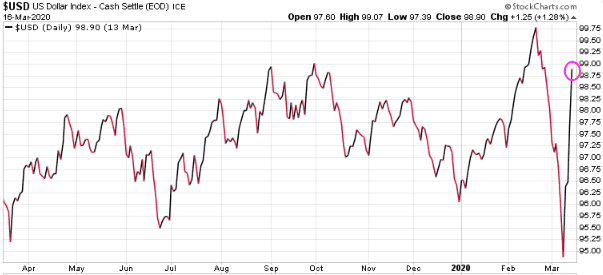Unfolding Bond Crisis: A Deeper Look At The Market's Vulnerability

Table of Contents
Rising Interest Rates and Their Impact on Bond Prices
The inverse relationship between interest rates and bond prices is a fundamental principle of fixed-income investing. When interest rates rise, newly issued bonds offer higher yields, making existing bonds with lower coupon rates less attractive. This reduced demand leads to a decline in the prices of existing bonds. Aggressive rate hikes by central banks globally, aimed at combating inflation, have significantly exacerbated this effect.
- Increased borrowing costs for governments and corporations: Higher interest rates make it more expensive for governments and corporations to borrow money, impacting their ability to finance operations and investments.
- Reduced demand for existing bonds, leading to price declines: As new bonds offer higher yields, investors shift their investments away from existing lower-yielding bonds.
- Potential for capital losses for bondholders: Bondholders holding bonds to maturity will receive their face value, but those selling before maturity will likely experience capital losses due to the price decline.
- The impact on different types of bonds: The impact of rising interest rates varies across different bond types. Government bonds, generally considered safer, are less affected than corporate bonds, which carry higher default risk, especially high-yield or junk bonds. The sensitivity of bond prices to interest rate changes is measured by duration. Longer duration bonds are more sensitive to interest rate changes.
Inflation's Role in Exacerbating the Bond Crisis
Persistent inflation erodes the purchasing power of fixed-income investments like bonds. When inflation rises, the real return (the return after adjusting for inflation) on a bond decreases. This makes bonds less attractive to investors seeking to preserve their capital. Central banks face the difficult task of controlling inflation without triggering a recession. Aggressive interest rate hikes, while effective in curbing inflation, also increase the risk of a recession and negatively affect bond markets.
- The impact of high inflation on real bond yields: High inflation significantly reduces real bond yields, making bonds a less attractive investment.
- The pressure on central banks to raise interest rates further: Persistent inflation puts pressure on central banks to continue raising interest rates, further impacting bond prices and yields.
- The risk of stagflation and its implications for bond markets: Stagflation (a combination of high inflation and slow economic growth) poses a significant threat to bond markets, making investors extremely risk-averse.
- The relationship between inflation expectations and bond prices: Market expectations about future inflation significantly impact bond prices. If inflation expectations rise, bond prices will generally fall.
Geopolitical Risks and Their Contribution to Market Uncertainty
Geopolitical events, such as the war in Ukraine and rising US-China tensions, introduce significant uncertainty into global bond markets. This uncertainty fuels risk aversion, leading investors to seek safe-haven assets and avoid riskier bonds.
- Increased demand for safe-haven assets (e.g., US Treasuries): During times of geopolitical uncertainty, investors flock to assets perceived as safe, like US Treasury bonds.
- Flight to quality from riskier bonds: Investors tend to sell riskier bonds, such as high-yield corporate bonds and emerging market bonds, and invest in safer government bonds.
- Potential for contagion effects across global bond markets: Negative developments in one region can easily spread to other markets, leading to a broader sell-off in bonds.
- The impact of sanctions and geopolitical instability on bond yields: Sanctions imposed on certain countries can significantly increase the yields of bonds issued by those countries due to increased default risk.
Assessing the Vulnerability of Different Bond Markets
The vulnerability of different bond markets varies significantly. Developed market bonds are generally considered less risky than emerging market bonds. However, even developed market bonds are vulnerable to interest rate hikes and inflation. Emerging market bonds carry additional risks associated with currency fluctuations, political instability, and higher default risk.
- Diversification strategies for managing risk: Diversification across different bond markets, maturities, and credit ratings is crucial for reducing risk.
- The importance of due diligence in bond investments: Thorough research and understanding of the issuer's creditworthiness are essential before investing in any bond.
- Identifying high-risk and low-risk bond markets: Investors must carefully assess the risk profile of different bond markets before allocating their capital.
- Evaluating credit ratings and default risk: Credit ratings provide an indication of the issuer's creditworthiness. Higher credit ratings indicate lower default risk.
Navigating the Bond Market Amidst the Crisis
Navigating the current bond market requires a cautious and adaptable approach. Investors should focus on risk management and consider strategies to mitigate potential losses.
- Rebalancing portfolios to adjust to changing market conditions: Regularly rebalancing the bond portfolio ensures that the allocation aligns with the investor's risk tolerance and market conditions.
- Exploring alternative fixed-income investments: Investors may consider alternative fixed-income investments, such as floating-rate notes or inflation-protected securities, to mitigate the impact of rising interest rates and inflation.
- Considering hedging strategies to protect against losses: Hedging strategies, such as using interest rate futures, can help protect bond portfolios from losses during periods of interest rate volatility.
- The importance of professional financial advice: Seeking advice from a qualified financial advisor can be invaluable in navigating the complexities of the bond market during a crisis.
Conclusion
The unfolding bond crisis presents significant challenges for investors. Understanding the interplay of rising interest rates, persistent inflation, and geopolitical risks is crucial for navigating the market's vulnerability. By carefully assessing risk, diversifying portfolios, and employing appropriate risk management strategies, investors can position themselves to weather the storm and potentially capitalize on opportunities within the evolving bond market landscape. Stay informed about the latest developments in the bond market and consider consulting with a financial advisor to develop a robust investment strategy tailored to your specific needs and risk tolerance. Remember to stay updated on the evolving bond crisis and adapt your strategies accordingly. Don't hesitate to seek professional guidance to manage your bond portfolio effectively during these volatile times. Understanding the nuances of the bond market crisis and its impact on various fixed income investments is key to making informed decisions.

Featured Posts
-
 Bayer Leverkusens New Coach 10 Defining Characteristics Of Erik Ten Hag
May 28, 2025
Bayer Leverkusens New Coach 10 Defining Characteristics Of Erik Ten Hag
May 28, 2025 -
 Wards Grand Slam In 9th Leads Angels To Victory Over Padres
May 28, 2025
Wards Grand Slam In 9th Leads Angels To Victory Over Padres
May 28, 2025 -
 Ipswich Town News Injury Update On Muric And Decisions On Tuanzebe Phillips And Chaplin
May 28, 2025
Ipswich Town News Injury Update On Muric And Decisions On Tuanzebe Phillips And Chaplin
May 28, 2025 -
 Belanda Dan Spanyol Berbagi Poin Hasil 2 2 Di Uefa Nations League
May 28, 2025
Belanda Dan Spanyol Berbagi Poin Hasil 2 2 Di Uefa Nations League
May 28, 2025 -
 Discover Wrexham History Culture And Attractions
May 28, 2025
Discover Wrexham History Culture And Attractions
May 28, 2025
Latest Posts
-
 Bernard Kerik Former Nypd Commissioner Undergoes Hospital Treatment
May 31, 2025
Bernard Kerik Former Nypd Commissioner Undergoes Hospital Treatment
May 31, 2025 -
 The Family Of Bernard Kerik Focusing On Hala Matli And Their Children
May 31, 2025
The Family Of Bernard Kerik Focusing On Hala Matli And Their Children
May 31, 2025 -
 Health Update Former Nypd Commissioner Kerik Hospitalized Expected To Recover Fully
May 31, 2025
Health Update Former Nypd Commissioner Kerik Hospitalized Expected To Recover Fully
May 31, 2025 -
 Bernard Kerik And Hala Matli Family Life And Children
May 31, 2025
Bernard Kerik And Hala Matli Family Life And Children
May 31, 2025 -
 Nypds Bernard Kerik Hospitalized Doctors Expect Full Recovery
May 31, 2025
Nypds Bernard Kerik Hospitalized Doctors Expect Full Recovery
May 31, 2025
